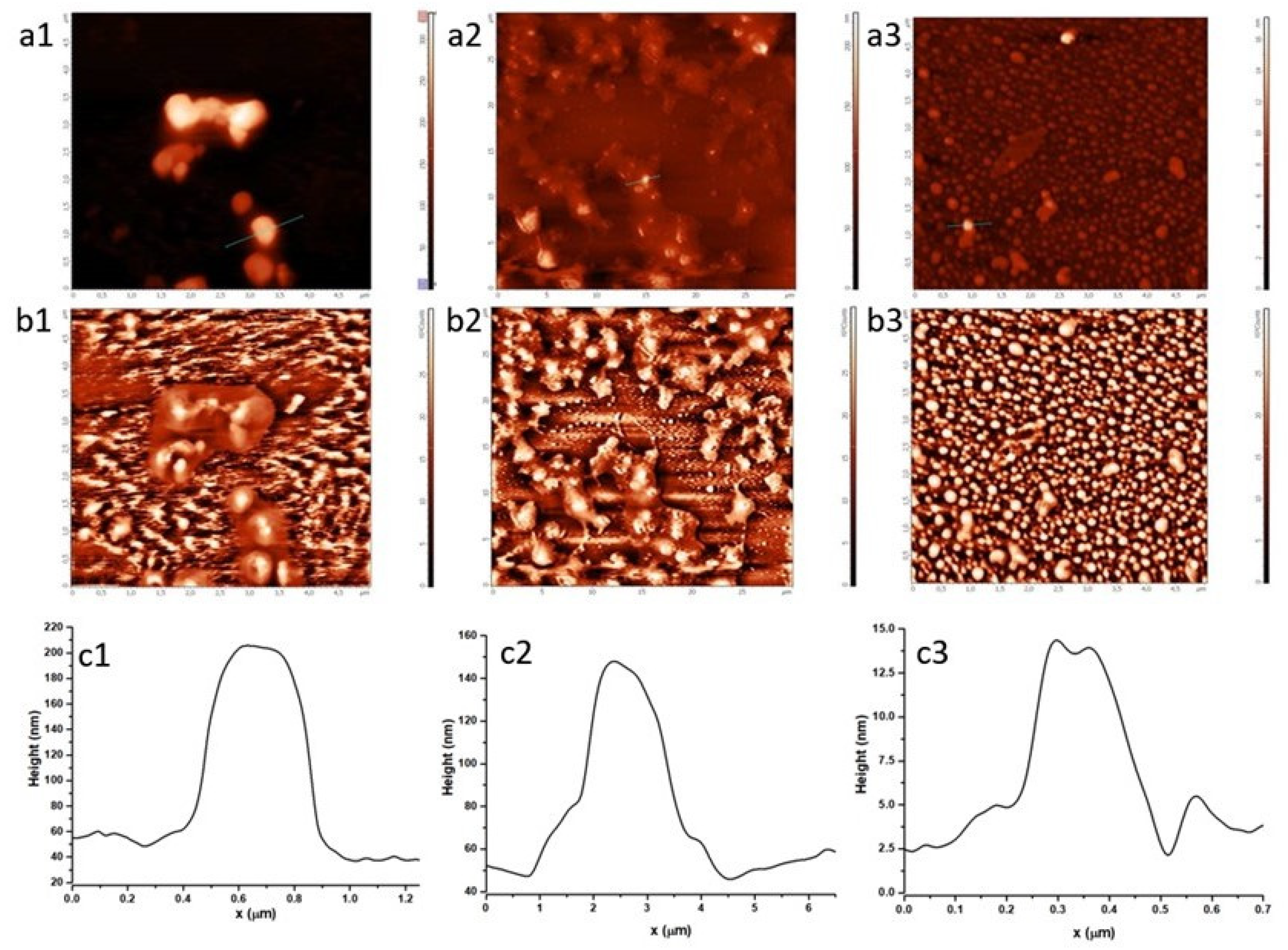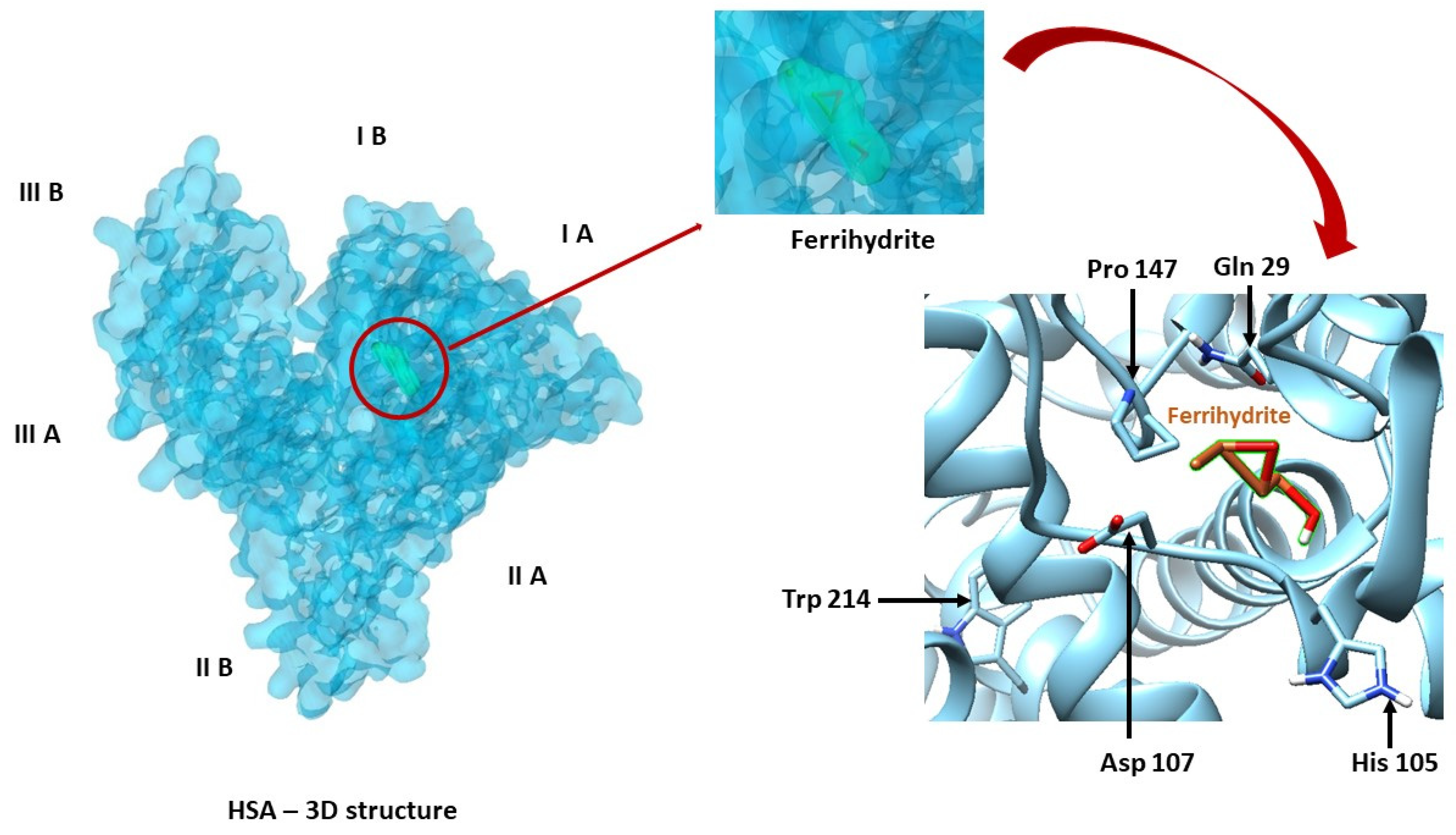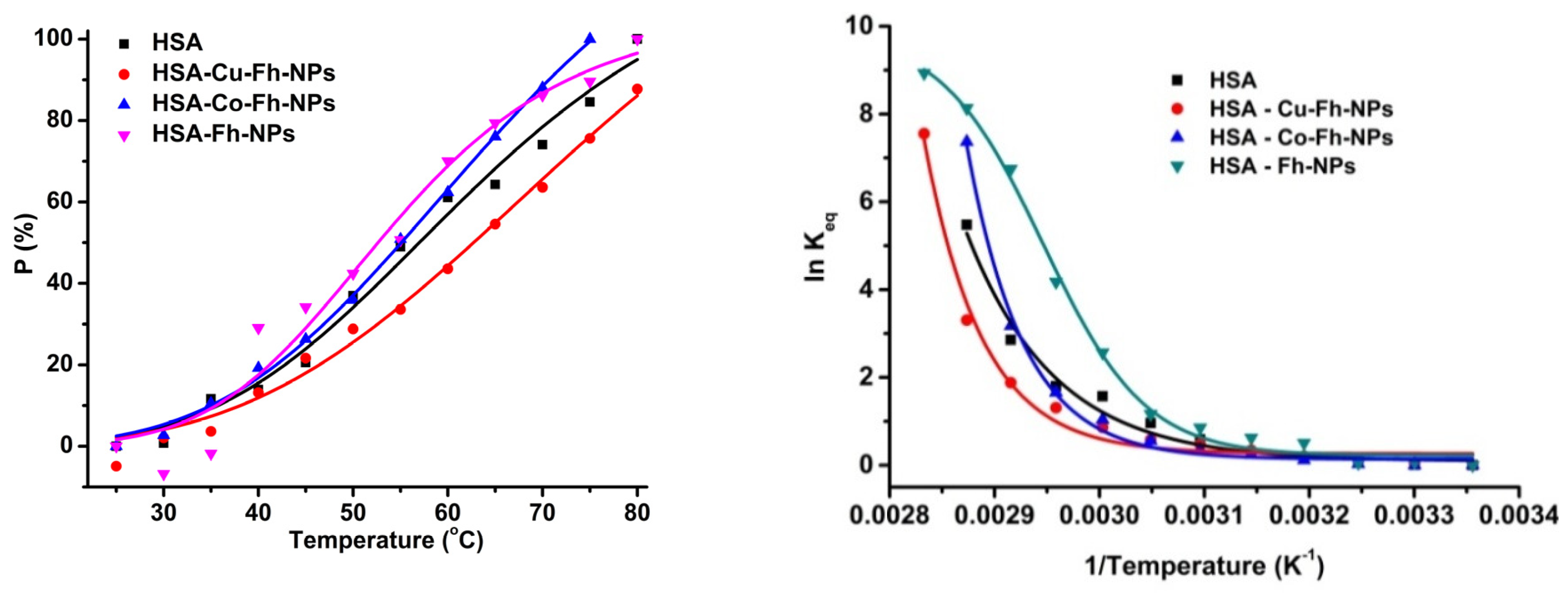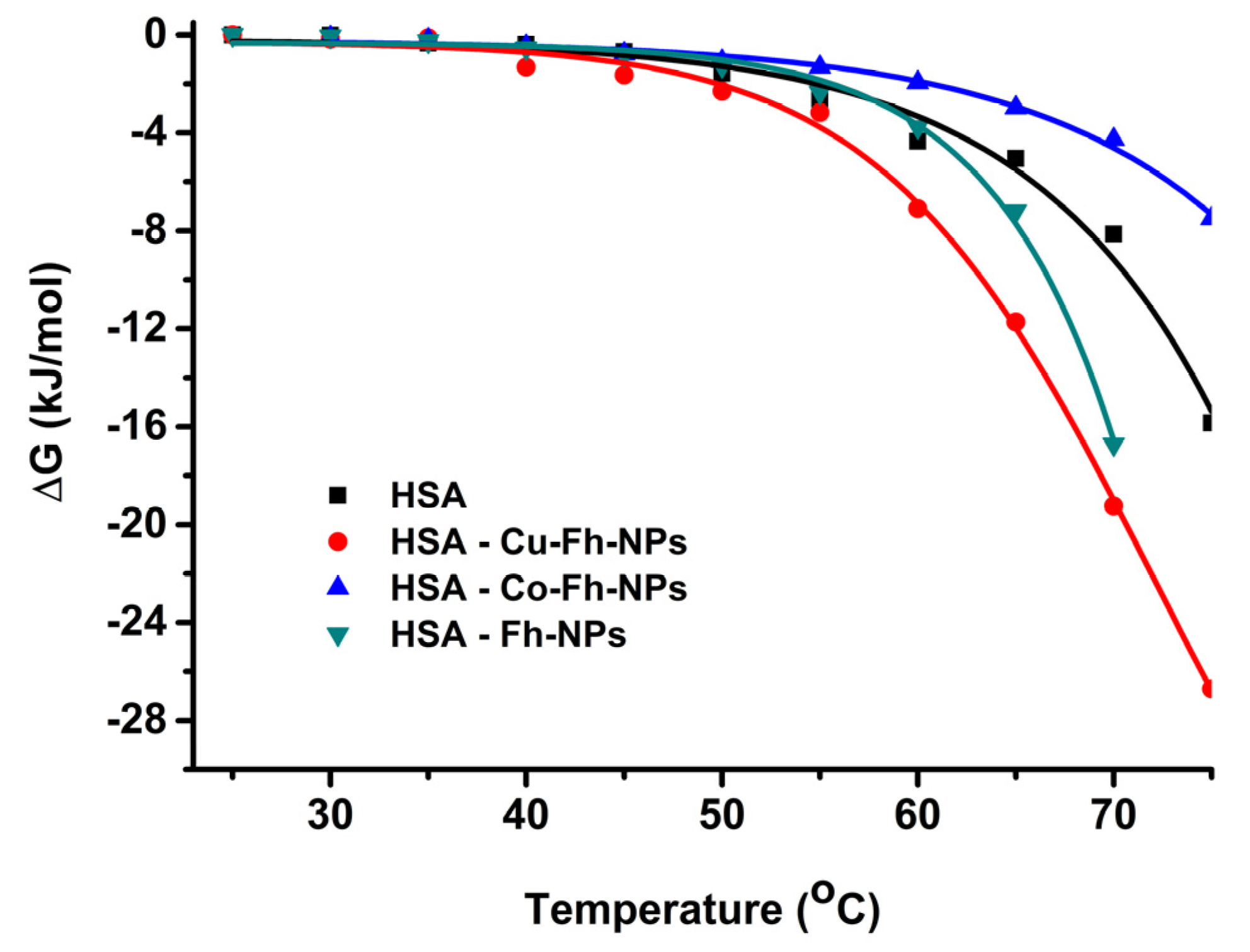Exploring the Conformation and Thermal Stability of Human Serum Albumin Corona of Ferrihydrite Nanoparticles
Abstract
:1. Introduction
2. Results and Discussions
2.1. Characterization of Ferrihydrite Nanoparticles by Scanning Electron Microscopy
2.2. Characterization of HSA Corona around Fh-NPs by Atomic Force Microscopy
2.3. Binding of Fh to HSA by Molecular Docking
2.4. Trp as a Spectral Sensor to Monitor HSA Thermal Stability
3. Materials and Methods
4. Conclusions
Author Contributions
Funding
Acknowledgments
Conflicts of Interest
References
- Demchenko, A.P. Nanoparticles and nanocomposites for fluorescence sensing and imaging. Methods Appl. Fluoresc. 2013, 1, 022001. [Google Scholar] [CrossRef] [PubMed]
- Gebauer, J.S.; Malissek, M.; Simon, S.; Knauer, S.K.; Maskos, M.; Stauber, R.H.; Peukert, W.; Treuel, L. Impact of the nanoparticle-protein corona on colloidal stability and protein structure. Langmuir 2012, 28, 9673–9679. [Google Scholar] [CrossRef] [PubMed]
- Omanovic-Miklicanin, E.; Manfield, I.; Wilkins, T. Application of isothermal titration calorimetry in evaluation of protein-nanoparticle interactions. J. Therm. Anal. Calorim. 2017, 127, 605–613. [Google Scholar] [CrossRef] [Green Version]
- Pareek, V.; Bhargava, A.; Bhanot, V.; Gupta, R.; Jain, N.; Panwar, J. Formation and characterization of protein corona around nanoparticles: A review. J. Nanosci. Nanotechnol. 2018, 18, 6653–6670. [Google Scholar] [CrossRef] [PubMed]
- Gräfe, C.; Weidner, A.; Lühe, M.V.; Bergemann, C.; Schacher, F.H.; Clement, J.H.; Dutz, S. Intentional formation of a protein corona on nanoparticles: Serum concentration affects protein corona mass, surface charge, and nanoparticle-cell interaction. Int. J. Biochem. Cell Biol. 2016, 75, 196–202. [Google Scholar]
- Pearson, R.M.; Juettner, V.V.; Hong, S. Biomolecular corona on nanoparticles: A survey of recent literature and its implications in targeted drug delivery. Front. Chem. 2014, 108. [Google Scholar] [CrossRef]
- Li, L.; Mu, Q.; Zhang, B.; Yan, B. Analytical strategies for detecting nanoparticle-protein interactions. Analyst 2010, 135, 1519–1530. [Google Scholar] [CrossRef] [Green Version]
- Chilom, C.; Barangă, G.; Găzdaru, D.; Popescu, A. A spectroscopic approach of pH effect on thermal denaturation of human and bovine serum albumins. JOAM 2011, 13, 583–587. [Google Scholar]
- Chilom, C.; Barangă, G.; Găzdaru, D.; Popescu, A. Characterisation by fluorescence of human and bovine serum albumins in interaction with eosin Y. J. Optoelectron. Adv. 2013, 15, 311–316. [Google Scholar]
- Chilom, C.G.; Zorilă, B.; Popescu, A.I. Characterization of some physico-chemical properties and interactions of human and bovine serum albumins with Mitomycin C. Rom. J. Phys. 2017, 62, 702. [Google Scholar]
- Chilom, C.; Nistorescu, A. A spectroscopic study of the interaction of HSA with tetracaine. Indian J. Biochem. Biophys. 2016, 53, 206–211. [Google Scholar]
- Sandu, N.; Chilom, C.G.; David, M.; Florescu, M. Evaluation of the interaction of levothyroxine with bovine serum albumin using spectroscopic and molecular docking studies. J. Biomol. Struct. Dyn. 2020. [Google Scholar] [CrossRef] [PubMed]
- Chilom, C.G.; Bacalum, M.; Stanescu, M.; Florescu, M. Insight into the interaction of human serum albumin with folic acid: A biophysical study. Spectrochim. Acta A Mol. Biomol. Spectrosc. 2018, 204, 648–656. [Google Scholar] [CrossRef] [PubMed]
- Sandu, N.; Chilom, C.G.; Popescu, A.I. Spectroscopic insights on the binding of rutin to bovine serum albumin. Rom. J. Phys. 2020, 65, 703. [Google Scholar]
- Chilom, C.G.; Florescu, M.; David, M. Monitoring biomolecular interaction between folic acid and bovine serum albumin. Spectrochim. Acta A Mol. Biomol. Spectrosc. 2020, 230, 118074–118083. [Google Scholar] [CrossRef]
- Yang, Q.; Liang, J.; Han, H. Probing the interaction of magnetic iron oxide nanoparticles with bovine serum albumin by spectroscopic techniques. J. Phys. Chem. 2009, 113, 10454–10458. [Google Scholar] [CrossRef]
- Raikher, Y.L.; Stepanov, V.I.; Stolyar, S.V.; Ladygina, V.P.; Balaev, D.A.; Ishchenko, L.; Balasoiu, M. Magnetic properties of biomineral particles produced by bacteria Klebsiella oxytoca. Phys. Solid State 2010, 52, 298–305. [Google Scholar] [CrossRef]
- Knyazev, Y.V.; Balaev, D.A.; Stolyar, S.V.; Bayukov, O.A.; Yaroslavtsev, R.N.; Ladygina, V.P.; Velikanov, D.A.; Iskhakov, R.S. Magnetic anisotropy and core-shell structure origin of the biogenic ferrihydrite nanoparticles. J. Alloys Compd. 2021, 851, 156753. [Google Scholar] [CrossRef]
- Zhou, L.; Liu, J.; Wei, S.; Ge, X.; Zhou, J.; Yu, B.; Shen, J. A facile drug delivery system preparation through the interaction between drug and iron ion of transferrin. J. Nanopart. Res. 2013, 15, 1929. [Google Scholar] [CrossRef]
- Mornet, S.; Vasseur, S.; Grasset, F.; Duguet, E. Magnetic nanoparticle design for medical diagnosis and therapy. J. Mater. Chem. 2004, 14, 2161–2175. [Google Scholar] [CrossRef]
- Ishchenko, L.A.; Stolyar, S.V.; Ladygina, V.P.; Raikher, Y.L.; Balasoiu, M.; Bayukov, O.A.; Iskhakov, R.S.; Inzhevatkin, E.V. Magnetic properties and application of biomineral particles produced by bacterial culture. Phys. Procedia 2010, 92, 279–282. [Google Scholar] [CrossRef]
- Chilom, C.G.; Gazdaru, D.M.; Bacalum, M.; Balasoiu, M.; Stoler, S.; Popescu, A.I. Biomedical application of biogenic ferrihydrite nanoparticles. Rom. Rep. Phys. 2017, 62, 701. [Google Scholar]
- Sukhanova, A.; Bozrova, S.; Sokolov, P.; Berestovoy, M.; Karaulov, A.; Nabiev, I. Dependence of nanoparticle toxicity on their physical and chemical properties. Nanoscale Res. Lett. 2018. [Google Scholar] [CrossRef] [PubMed] [Green Version]
- Chilom, C.G.; Sandu, N.; Bălăşoiu, M.; Yaroslavtsev, R.N.; Stolyar, S.V.; Rogachev, A.V. Ferrihydrite nanoparticles insights: Structural characterization, lactate dehydrogenase binding and virtual screening assay. Int. J. Biol. Macromol. 2020, 164, 3559–3567. [Google Scholar] [CrossRef]
- Wu, W.; Wu, Z.; Yu, T.; Jiang, C.; Kim, W.S. Recent progress on magnetic iron oxide nanoparticles: Synthesis, surface functional strategies and biomedical applications. Sci. Technol. Adv. Mater. 2015, 16, 023501. [Google Scholar] [CrossRef]
- Mohanraj, K.; Sivakumar, G. Synthesis of γ-Fe2O3, Fe3O4 and copper doped Fe3O4 nanoparticles by sonochemical method. Sains Malays. 2017, 46, 1935–1942. [Google Scholar] [CrossRef]
- Mariam, J.; Sivakami, S.; Dongre, P.M. Albumin corona on nanoparticles–A strategic approach in drug delivery. Drug Deliv. 2016, 23, 2668–2676. [Google Scholar] [CrossRef] [Green Version]
- Karmali, P.P.; Simberg, D. Interactions of nanoparticles with plasma proteins: Implication on clearance and toxicity of drug delivery systems. Expert. Opin. Drug Deliv. 2011, 8, 343–357. [Google Scholar] [CrossRef]
- Nguyen, V.H.; Meghani, N.M.; Amin, H.H.; Tran, T.T.D.; Tran, P.H.L.; Park, C.; Lee, B.J. Modulation of serum albumin protein corona for exploring cellular behaviors of fattigation-platform nanoparticles. Coll. Surf. B. Biointerfaces 2018, 170, 179–186. [Google Scholar] [CrossRef]
- Chilom, C.G.; Zorilă, B.; Bacalum, M.; Bălăşoiu, M.; Yaroslavtsev, R.; Stolyar, S.V.; Tyutyunnicov, S. Ferrihydrite nanoparticles interaction with model lipid membranes. Chem. Phys. Lipids 2020, 226, 104851. [Google Scholar] [CrossRef]
- Lynch, I.; Dawson, A. Protein-nanoparticle interactions. Nanotoday 2008, 3, 40–47. [Google Scholar] [CrossRef]
- Skakauskas, V.; Katauskis, P. Modeling of a single nanoparticle interaction with the human blood plasma proteins. J. Biol. Phys. 2018, 44, 605–617. [Google Scholar] [CrossRef] [PubMed]
- Hedberg, Y.S.; Dobryden, I.; Chaudhary, H.; Wei, Z.; Claesson, P.M.; Lendel, C. Synergistic effects of metal-induced aggregation of human serum albumin. Colloids Surf. B. 2019, 173, 751–758. [Google Scholar] [CrossRef] [PubMed]
- Bar-Or, D.; Rael, L.T.; Bar-Or, R.; Slone., D.S.; Mains, C.W.; Rao, N.K.R.; Curtis, C.G. The cobalt-albumin binding assay: Insights into its mode of action. Clin. Chimica Acta 2008, 387, 120–127. [Google Scholar] [CrossRef]
- Jokiel, M.; Klajnert, B.; Bryszewska, M. Use of a Spectrofluorimetric method to monitor changes of human serum albumin thermal stability in the presence of polyamidoamine dendrimers. J. Fluoresc. 2006, 16, 149–152. [Google Scholar] [CrossRef]
- Cimmperman, P.; Baranauskienė, L.; Jachno, J.; Torresan, J.; Michailovienė, V.; Matulienė, J.; Sereikaitė, J.; Bumelis, V.; Matulis, D. A quantitative model of thermal stabilization and destabilization of proteins by ligands. Biophys. J. 2008, 95, 3222–3231. [Google Scholar] [CrossRef] [Green Version]
- Pace, C.N.; Scholtz, J.M.; Grimsley, G.R. Forces stabilizing proteins. FEBS Lett. 2014, 558, 2177–2184. [Google Scholar] [CrossRef] [Green Version]
- Al-Jawad, S.M.H.; Taha, A.A.; Al-Halbosiy, M.M.F.; Al-Barram, L.F.A. Synthesis and characterization of small-sized gold nanoparticles coated by bovine serum albumin (BSA) for cancer photothermal therapy. photodiagnosis photodyn. Therapy 2018, 21, 201–210. [Google Scholar]
- Pace, C.N.; Vajdos, F.; Lanette, F.E.; Grimsley, G.; Theronica, G. How to measure and predict the molar absorption coefficient of a protein. Protein Sci. 1995, 4, 411–2423. [Google Scholar] [CrossRef] [Green Version]
- Stolyar, S.V.; Yaroslavtsev, R.N.; Iskhakov, R.S.; Bayukov, O.A.; Balaev, D.A.; Dubrovskii, A.A.; Krasikov, A.A.; Ladygina, V.P.; Vorotynov, A.M.; Volochaev, M.N. Magnetic and resonance properties of ferrihydrite nanoparticles doped with cobalt. Phys. Solid State 2017, 59, 555–563. [Google Scholar] [CrossRef]
- Stolyar, S.V.; Yaroslavtsev, R.N.; Bayukov, O.A.; Balaev, D.A.; Krasikov, A.A.; Iskhakov, R.S.; Vorotynov, A.M.; Ladygina, V.P.; Purtov, K.V.; Volochaev, M.N. Preparation, structure and magnetic properties of synthetic ferrihydrite nanoparticles. J. Phys. Conf. Ser. 994 2018, 012003. [Google Scholar] [CrossRef]
- Sugio, S.; Kashima, A.; Mochizuki, S.; Noda, M.; Kobayashi, K. Crystal structure of human serum albumin at 2.5 Å resolution. Protein Eng. Des. Sel. 1999, 12, 439–446. [Google Scholar] [CrossRef] [PubMed]
- RCSB. Available online: https://www.rcsb.org/structure/1ao6/ (accessed on 9 September 2020).
- Berman, H.M.; Westbrook, J.; Feng, Z.; Gilliland, G.; Bhat, T.N.; Weissig, H.; Shindyalov, I.N.; Bourne, P.E. The protein data bank. Nucl. Acids. Res. 2000, 28, 235–242. [Google Scholar] [CrossRef] [PubMed] [Green Version]
- Crystallography Open Database. Available online: https://wiki.crystallography.net/cod/citing/ (accessed on 9 September 2020).
- Dallakyan, S.; Olson, A.J. Small-molecule library screening by docking with PyRx. Methods Mol. Biol. 2015, 1263, 243–250. [Google Scholar] [PubMed]
- Trott, O.; Olson, A.J. AutoDock Vina: Improving the speed and accuracy of docking with a new scoring function, efficient optimization and multithreading. J. Comput. Chem. 2010, 31, 455–461. [Google Scholar] [CrossRef] [PubMed] [Green Version]
- Pettersen, E.F.; Goddard, T.D.; Huang, C.C.; Couch, G.S.; Greenblatt, D.M.; Meng, E.C.; Ferrin, T.E. UCSF Chimera–A visualization system for exploratory research and analysis. J. Comput. Chem. 2004, 25, 1605–1612. [Google Scholar] [CrossRef] [PubMed] [Green Version]






Publisher’s Note: MDPI stays neutral with regard to jurisdictional claims in published maps and institutional affiliations. |
© 2020 by the authors. Licensee MDPI, Basel, Switzerland. This article is an open access article distributed under the terms and conditions of the Creative Commons Attribution (CC BY) license (http://creativecommons.org/licenses/by/4.0/).
Share and Cite
Chilom, C.G.; Bălan, A.; Sandu, N.; Bălăşoiu, M.; Stolyar, S.; Orelovich, O. Exploring the Conformation and Thermal Stability of Human Serum Albumin Corona of Ferrihydrite Nanoparticles. Int. J. Mol. Sci. 2020, 21, 9734. https://doi.org/10.3390/ijms21249734
Chilom CG, Bălan A, Sandu N, Bălăşoiu M, Stolyar S, Orelovich O. Exploring the Conformation and Thermal Stability of Human Serum Albumin Corona of Ferrihydrite Nanoparticles. International Journal of Molecular Sciences. 2020; 21(24):9734. https://doi.org/10.3390/ijms21249734
Chicago/Turabian StyleChilom, Claudia G., Adriana Bălan, Nicoleta Sandu, Maria Bălăşoiu, Sergey Stolyar, and Oleg Orelovich. 2020. "Exploring the Conformation and Thermal Stability of Human Serum Albumin Corona of Ferrihydrite Nanoparticles" International Journal of Molecular Sciences 21, no. 24: 9734. https://doi.org/10.3390/ijms21249734
APA StyleChilom, C. G., Bălan, A., Sandu, N., Bălăşoiu, M., Stolyar, S., & Orelovich, O. (2020). Exploring the Conformation and Thermal Stability of Human Serum Albumin Corona of Ferrihydrite Nanoparticles. International Journal of Molecular Sciences, 21(24), 9734. https://doi.org/10.3390/ijms21249734




